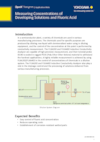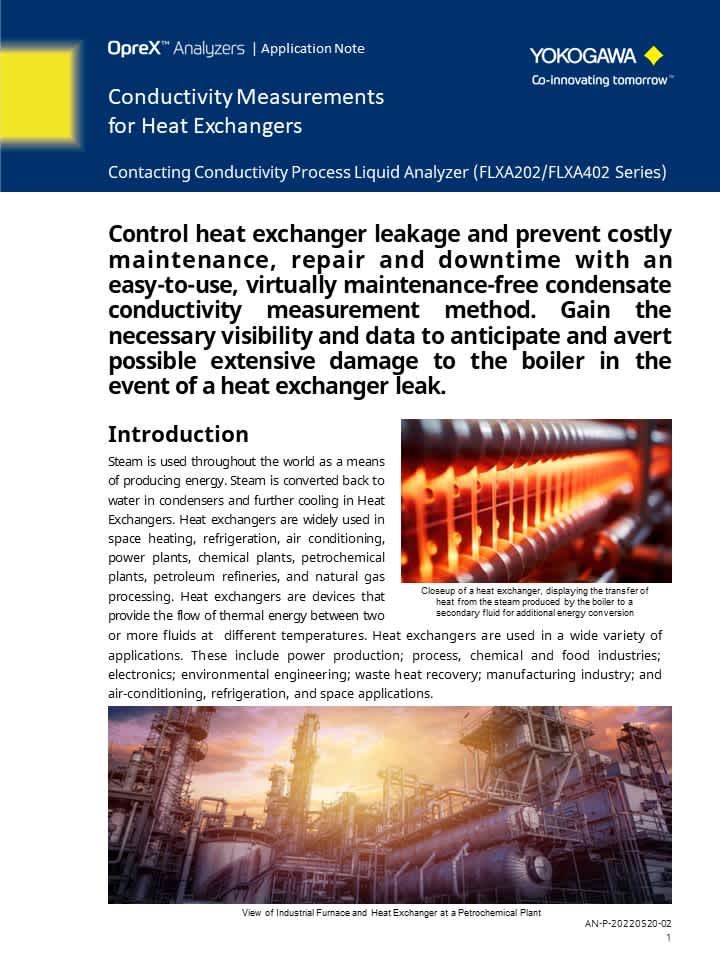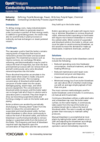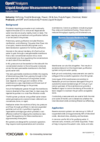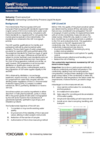 Yokogawa is a recognized world leader for reliable conductivity equipment, providing credible and repeatable measurement solutions for maintaining and controlling even the most demanding process applications.
Yokogawa is a recognized world leader for reliable conductivity equipment, providing credible and repeatable measurement solutions for maintaining and controlling even the most demanding process applications.
Yokogawa offers conductivity analyzers suitable for measuring the two most common conductivity measurement methods: contacting and inductive (also known as toroidal or electrodeless). These analyzers are highly precise, durable for harsh conditions, and require minimal maintenance, helping to improve efficiency and reduce costs.
| FLXA202/21 | FLXA402 | |
|---|---|---|
| Area Classification | General Purpose, Class I Div II, Class I Div I | General Purpose, FM Class I Div II pending |
| Power Supply | 2-Wire Loop Powered 24VDC | 4-Wire 100-240 VAC; 4-Wire 12-24 VDC |
| Communication | 4-20mA, HART, FF and PA* | 4-20mA, HART, Ethernet (Modbus TCP), RS-485 (Modbus RTU) |
| Contacts and Relays | N/A | 4 SPDT relay contacts with display indicators |
| Measurement Type | Contacting Conductivity, Resistivity Inductive Conductivity, Percent Concentration |
pH, ORP (oxidation- reduction potential) , Contacting Conductivity, Resistivity Inductive Conductivity, Percent Concentration, Dissolved Oxygen and 4-20 mA input |
*FF and PF available in the Plastic FLXA21 for contacting conductivity and resistivity
-
Multi Channel 4-Wire Analyzer FLXA402
Available in single or multi-sensor measurement
-
2-Wire Transmitter/Analyzer FLXA202
Most flexible two-wire analyzer available
-
2-Wire Transmitter/Analyzer FLXA21
The FLEXA™ series analyzers are used for continuous on-line measurements in industrial installations. With an option for single or dual sensor measurement, they are the most flexible two-wire analyzer available.
-
Portable Conductivity Meter SC92
Tough and easy-to-use portable conductivity meter (SC meter) that can measure a wide range of conductivity from pure water to seawater. For your daily measurement partner.
-
Portable Conductivity Handheld Meter SC72
Ideal for field use
Details
What Are Conductivity Analyzers?
Conductivity transmitters, meters, and analyzers are used for continuous process measurement and monitoring of conductivity, resistivity, WIFI, demineralizer water, RO water, percent concentration, boiler blowdown, and TDS.
What Are the Benefits of Conductivity Analyzers?
Accurate Conductivity measurement in CIP reduces operating costs. Predictive maintenance and sensor wellness functions help reduce unplanned outages and lost production time. To ensure maximum precision, Yokogawa’s conductivity analyzers include twelve preprogrammed and two user-defined temperature compensation matrices.
What Are Conductivity Analyzer Applications?
Water Purification
Brine Manufacturing
Brine is often used within industrial processes such as food and beverage, refineries, textile dyeing house, and chemical plants as well as in municipalities, or for commercial use, as a final product applied to pavement roadways or commercial parking lots as an anti-icing or de-icing agent.
Conductivity measurement is a reliable indicator of the real-time brine concentration. Utilizing process analyzers including online conductivity meters removes the need for timely grab sample analysis. Yokogawa’s inductive conductivity analyzers increase efficiency and reduce operating costs while realizing reliable brine concentration measurements.

Boiler Blowdown
The frequency and duration required for boiler blowdown is significantly affected by water quality. Raw water used to feed the boilers contains varying levels of impurities that must be removed to protect the boiler and associated equipment. Pretreatment processes such as reverse osmosis, ion exchange, filtration, softening and demineralization may be used to reduce the level of impurities. Unfortunately, even the best pretreatment processes will not remove all impurities and will continuously carry some dissolved mineral impurities into the boiler.
Improving feedwater quality through make-up water, chemical treatment, and proper blowdown control can significantly reduce costs including:
- Reduced operating costs
- Reduced maintenance and repair costs
- Cleaner and more efficient steam
- Energy savings
- Increase efficiency and reduce operating costs using Yokogawa’s conductivity products.

Pharmaceutical Waters
Yokogawa’s conductivity transmitters and converters possess USP (United States Pharmacopoeia) functions to simplify and automate USP requirements. The FLEXA two-wire conductivity transmitter has the USP23/24 Stage One table pre-programmed in its software. When enabled, the transmitter will send a FAIL signal when the water exceeds the USP limit and can display and transmit the uncompensated conductivity that USP mandates for compliance recording.
 The SC450 and DC402 four-wire conductivity converters have additional USP features with the ability to display and transmit the uncompensated conductivity for USP compliance, as well as the NaCl temperature compensated measurement, valuable for process control.
The SC450 and DC402 four-wire conductivity converters have additional USP features with the ability to display and transmit the uncompensated conductivity for USP compliance, as well as the NaCl temperature compensated measurement, valuable for process control.
The USP23/24 Stage One table is pre-programmed into these instruments, and a FAIL alarm will be given if the conductivity limits are exceeded. Alarms on these units can be dedicated as USP “warning” alarms with user-defined safety margins. These “warning” alarms will inform the operator that his/ or her water is trending towards the USP limit and will allow him/or her to take preemptive corrective action.
Demineralizer
Ion Exchange is a method for the exchange of ions between two electrolytes or between an electrolyte solution and a complex molecule. In most cases, the term denotes the processes of purification, separation, and decontamination of aqueous and other ion-containing solutions with solid polymeric or mineralic ion exchangers.
The dual channel process liquid analyzer gives users the ability to measure the bed’s inlets and outlets and calculate the ratio or % passage of the bed.

Heat Exchanger Leakage
Corrosion on the process side causes the heat exchanger tubing to mechanically fail, allowing the process fluid to leak into the condensate return line. This can cause serious damage to the boiler. Therefore, it is necessary to monitor the condensate downstream of the heat exchanger and to dump it as soon as it shows signs of contamination.
An excellent indication of contamination can be obtained by measuring the conductivity of the condensate because pure condensate has a very low conductivity value (1 to 10 µS) while contaminates (typically salts, acids or alkalis) that are introduced when leakage occurs have a significantly higher conductivity value. Because of the sizeable differences in values, even the slightest leak will sharply increase the conductivity reading. Any marked increase in the conductivity of the condensate indicates that leakage is present and that the condensate should be sent to drain.
Measurement and control of heat exchanger leakage can help prevent costly maintenance, repair, and downtime. The simple, essentially maintenance-free measurement of condensate conductivity gives operators the necessary information (or provides automatic control) to prevent severe damage to the boiler should a breakthrough of the heat exchanger occur.
Measuring the Electric Conductivity with Clean-in-Place (CIP) System
In the Pharmaceutical, Chemical and Food & Beverage industries, after manufacturing products, the cleaning and sterilization of tanks and piping are done with various cleaning solutions, fresh or hot water and steam. Clean-in-Place (CIP) is a system designed for automatic cleaning and disinfecting.
Yokogawa’s inductive conductivity liquid process analyzer takes measurements with good boundary surface precision over a wide range, earning it a reputation in the recovery of cleaning, which contributes significantly to reduce chemical and wastewater processing costs.
Percent Concentration
There are numerous industrial applications where measurements and/or control of a specific chemical strength of the process is critical for optimizing the production of the end product. These specific concentrations are obtained by mixing a full strength solution with water to achieve the desired percent concentration. Conductivity measurement is a reliable indicator of the concentration of most acid or base solutions.
Resources
Ion Exchange is a method for the exchange of ions between two electrolytes or between an electrolyte solution and a complex molecule. In most cases the term is used to denote the processes of purification, separation, and decontamination of aqueous and other ion-containing solutions with solid polymeric or mineralic ion exchangers.
In a semiconductor plant, a variety of chemicals are used in various manufacturing processes. The chemicals used for specific purposes are produced by diluting raw liquid with demineralized water using in diluting equipment, and the control of the concentration at this point is performed by conductivity measurement.
Heat exchangers are devices that provide the flow of thermal energy between two or more fluids at different temperatures. Heat exchangers are used in a wide variety of applications. These include power production; process, chemical and food industries; electronics; environmental engineering; waste heat recovery; manufacturing industry; and air-conditioning, refrigeration, and space applications. Yokogawa offers a means to control heat exchanger leakage and prevent costly maintenance, repair and downtime with an easy-to-use, virtually maintenance-free condensate conductivity measurement method.
To defray energy costs, many industrial plants have their own boilers to generate steam to produce a portion of their energy needs. In addition to generating power, the steam may also be used directly in plant processes or indirectly via heat exchangers or steam jacketed vessels.
Reverse osmosis (RO) is a separation process that uses pressure to force a solution through a membrane that retains the solute on one side and allows the pure solvent to pass to the other side. More formally, it is the process of forcing a solvent from a region of high solute concentration through a membrane to a region of low solute concentration by applying a pressure in excess of the osmotic pressure.
SMART digital sensors and advanced data management software enhance reliability and process safety.
Yokogawa’s Process Liquid Analyzers series help pigment producers achieve a more reliable and accurate analysis of pH during industrial bioprocesses, improving product quality with less total operation costs.
Questionable flow and conductivity measurements during CIP could raise questions about food quality and safety.
Conductivity measurement can be used as a reliable indicator of the real-time brine concentration. Using an online process analyzer removes the need for timely grab sample analysis.
The kraft process, also known as kraft pulping or the sulfate process, is a technology for conversion of wood into wood pulp that consists of almost pure cellulose fibers. Today, the kraft process is used in approximately 80% of paper production.
There are numerous industrial applications where measurements and/or control of a specific chemical strength of the process is critical for optimizing the production of the end product. These specific concentrations are obtained by mixing a full strength solution with water to achieve the desired percent concentration.
Yokogawa’s conductivity transmitters and converters possess USP functions that make this seemingly complex and troublesome requirement pain-free and automatic.
Get the most from what exists currently and take advantage of new methods. Appeared in the March 2021 issue of an ISA.org publication.
Downloads
Brochures
- Process Analyzers Analytical Instruments and Systems Overview
- FLXA402 4-Wire Liquid Analyzer, SA11 SENCOM Smart Adapter (15.1 MB)
- Co-innovating on Best-in-Class Analytical Solutions (317.7 KB)
- Importance of Analyzer Maintenance (193.8 KB)
- Electrolysis Solutions: Instrumentation Solutions for Electrolysis Plant Applications (841.1 KB)
Instruction Manuals
- ISC202SJ [Style: S1] 2-wire Inductive Conductivity Transmitter with Supplement (371 KB)
- Discontinued: SC72 Personal Conductivity Meter Quick Manual (343 KB)
- SC202SJ [Style: S2] 2-wire Transmitter for Conductivity or Resistivity with Supplement (1.3 MB)
- Discontinued: SC72 Personal Conductivity Meter (4.2 MB)
- DC402G Converter for Dual Cell Conductivity and Resistivity (2.9 MB)
- PH201G Distributor (1.1 MB)
General Specifications
- FLXA202 2-Wire Analyzer (1.7 MB)
- FLXA21 2-Wire Analyzer (1.1 MB)
- SC450G Conductivity / Resistivity Converter (854 KB)
- FLXA402 4-Wire Converter (1.5 MB)
Technical Information
- ISC450G Alarms and Outputs (93 KB)
- SC450G Proper Calibration (444 KB)
- FLXA21 Coating Procedure (235 KB)
- Process Liquid Analyzer Sensor Wiring Guide
- SC450G Quick Start Guide (86 KB)
- Contacting Conductivity sensor selection guide (1.6 MB)
MSDS/SDS
- K9221ZA / NaCl solution (280 KB)
Videos
In this 40 min session you will learn the fundamental requirements for aqueous conductivity measurements; the differences between "Contacting" and "Inductive" measurement techniques and which one to use for a particular application. As well as learn the importance of online diagnostics. The goal is to provide participants with simple techniques they can implement to improve their day to day operations and to identify causes of errors and how to correct them
Looking for more information on our people, technology and solutions?
Contact Us


